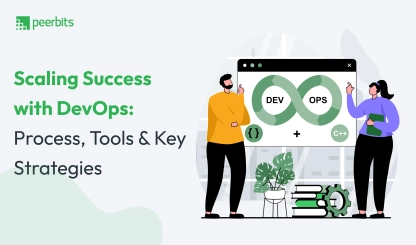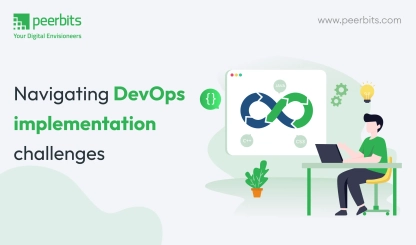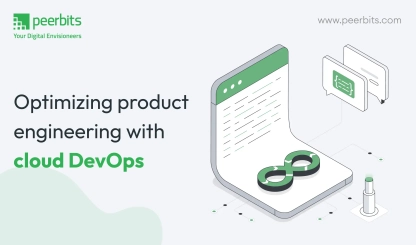In a world where AI is committed to taking over most of the human’s repetitive tasks, the race got the opportunity to be creative. But the biggest problem in making innovative ideas a reality is coding them into a functional app or software. Not anymore! We are entering a world where even beginners can navigate their way through complex codes if they have a precise blueprint of their ideas and a Low-code/no-code approach.
Yes, we are talking about the rise of low-code/no-code platforms. These innovative solutions allow teams to automate development and deployment processes through visual tools instead of advanced coding jargon. Simply, through the LCNC approach, any technical or non-technical user can easily contribute to application creation.
But how effective Low-code/No-code platforms can be for DevOps? Even a kid can guess the streamlining of the workflows and improvement of collaboration among DevOps teams.You need to look deeper!
Let’s roll up our adult sleeves to explore the core benefits, features, and future trends of low-code/no-code in DevOps, backed by compelling statistics and real-world examples.
Understanding low-code/no-code development
Low-code/no-code development refers to a software development approach that allows users to create applications with minimal or no coding experience. These platforms utilize visual interfaces, such as drag-and-drop features, to simplify the development process.
Worry not! These low-code and no-code frameworks are built on actual coding languages like PHP, Python, and Java. However, users of these tools have to deal with visual software development environments where they can drag and drop program components, link them, and see their ideas in actual motion.
As obvious from the name, Low code- requires minimal coding experience to create applications, while no-code platforms allow users to create applications without coding at all.
In a simple sense, Low code/no-code tools are perfect for those who either do not know how to code or have no time to code.
Low-code/No-code growth: Statistical insights
Nowadays, organizations already see the benefits of using Low-code/no-code platforms which is quite visible not only in theory but in numbers too. To assess whether your business or vision is falling behind or keeping up with the innovative race today, these Low-code/No-code stats can be highly useful.
Here are some detailed insights into the rise of Low-code/No-code development that you should focus on:

According to Statista, the global low-code platform market is forecasted to reach approximately 65 billion U.S. dollars by 2027.
Based on Statista, almost 60 percent of organizations indicated that using low code increases revenue and helps replace legacy systems.
In 2021, 29 percent of respondents from a global survey indicated that low-code development is between 40 to 60 percent faster than traditional development
Gartner once predicted that by 2024, 80% of apps will be developed by non-IT professionals. It is quite a closer view we see today with LCNCs now! Let’s explore how it has infiltrated the world of DevOps automation.
Rise of low-code/no-code in DevOps
As DevOps practices continue to mature, integrating low-code and no-code solutions has become a game-changer. The ability to automate repetitive tasks through low-code/no-code in DevOps has powered teams to focus on more strategic initiatives.
-
Low-code/no-code platforms can accelerate innovation by enabling developers to quickly spin up proofs-of-concept for more complex software development tasks that require coding expertise.
-
Ideas and solutions can be tested before investing time and resources in full-scale development with the help of LCNC in Devops
-
Recent studies show that companies adopting low-code and no-code tools experience a 70% reduction in deployment times, significantly enhancing their productivity.
-
Teams can quickly prototype, test, and deploy applications, leading to a more responsive development environment.
Moreover, the integration of low-code and no-code development platforms into DevOps workflows allows for faster iteration cycles. This agility is essential in today’s competitive landscape, where customer needs and market conditions can change rapidly. And to satiate such needs Low-code/No-code approach is a perfect solution.
Benefits of low-code/no-code in DevOps

Now even the business analysts, marketers, and other non-technical personnel can take a significant part in the development process due to low-code and no-code applications. No more fall backs caused by complete reliance on specialized developers.
In a way, Low-code/No-code has brought democracy in the world of development where agility and responsiveness are paramount. Let’s explore what are some crucial advantages Low-code/No-code development has brought for DevOps solutions:
1. Speed of development
One of the primary advantages of low code no code app development is the speed at which applications can be developed. Organizations can go from concept to deployment in a fraction of the time compared to traditional methods.
For instance, a project that might take months can often be completed in weeks or even days using no code application development tools.
2. Cost-effectiveness
Implementing low code no code applications can lead to substantial cost savings. Businesses can reduce their reliance on high-cost development resources, allowing them to allocate budgets more effectively.
A report from Forrester indicates that organizations using low-code platforms can save up to 50% on development costs, making it an attractive option for businesses of all sizes.
3. Accessibility
No code app builders democratize the development process. With these tools, users can make use of their domain expertise to build Android apps without coding, thus bridging the gap between IT and business.
This accessibility encourages innovation, as more individuals can contribute ideas and solutions without needing extensive technical training.
4. Collaboration
By using low-code and no-code systems, teams can improve collaboration across departments. Visual tools facilitate better communication, enabling stakeholders to provide input and feedback throughout the development process. This collaborative environment not only enhances the quality of the final product but also increases team morale and engagement.
Key features of Low-code/No-code platforms for DevOps

Low-code/no-code platforms offer several essential features that enhance their utility in DevOps:
-
Visual modeling tools: Enable users to design applications through drag-and-drop interfaces, making it easy to visualize workflows and processes.
-
Integration capabilities: Allow seamless connections with existing systems and third-party services, ensuring that new applications can work within the current tech ecosystem.
-
Pre-built templates: Accelerate the development process with reusable assets, reducing the need to start from scratch for every project.
-
Collaboration features: Support real-time editing and feedback loops among team members, promoting a more agile development environment.
These features collectively contribute to an enhanced and efficient development process, allowing teams to focus on delivering value rather than getting bogged down in technical details.
Now some real-life use cases of Low-code/no-code that can bring a phenomenal shift in your development lifecycle speed & efficiency.
Case studies showing Low-code/No-code success
1. Healthcare provider utilizing OutSystems
Overview: A leading healthcare provider utilised OutSystems, a low-code platform, to develop a comprehensive patient management system.
Challenges: The primary challenge was to enhance operational efficiency and improve the patient experience without extensive coding resources.
Impact: The implementation of OutSystems led to significant improvements in operational workflows and patient satisfaction, demonstrating the platform's capability to handle complex healthcare requirements effectively.
2. Retail chain boosting citizen developers with Microsoft Power Apps
Overview: A large retail chain empowered its non-technical staff, or citizen developers, to create custom applications using Microsoft Power Apps.
Challenges: The main challenge was optimizing inventory management and streamlining various retail processes without relying heavily on IT departments.
Impact: By using Microsoft Power Apps, the retail chain successfully optimized its inventory management and streamlined operations, showcasing the potential of low-code/no-code platforms to drive efficiency and innovation in retail.
Low-code/No-Code DevOps: Challenges and limitations

Despite the numerous benefits, the adoption of low-code and no-code applications is not without challenges. Some common misconceptions include the belief that LCNC platforms can completely replace traditional coding, which is not the case.
While they can significantly reduce the amount of coding required, complex applications may still necessitate some level of programming expertise. Here are some challenges in Low-Code/No-code that should be addressed:
-
Limited customization: Low-code/no-code platforms may restrict customization, hindering complex functionalities needed in DevOps.
-
Integration challenges: Seamless integration with legacy systems can be difficult, disrupting workflows and efficiency.
-
Scalability issues: Applications built on these platforms may struggle to scale effectively with growing user loads.
-
Security concerns: Lack of security expertise among users can introduce vulnerabilities, impacting data handling.
-
Vendor dependency: Reliance on vendor support for updates and maintenance can stall DevOps initiatives if not timely addressed.
Future trends in low-code/no-code DevOps
The future of low-code and no-code development looks promising, with predictions suggesting even greater adoption rates in the coming years.
-
Integration of AI and automation: Future low-code/no-code platforms are likely to incorporate advanced AI capabilities, enabling users to automate complex processes and enhance decision-making, thereby streamlining workflows and improving efficiency
-
Expansion of citizen development: The trend of citizen development will grow, empowering non-technical users to create applications, which will lead to a more democratized approach to software development and increased innovation within organizations.
-
Focus on security and governance: As low-code/no-code adoption rises, there will be a heightened emphasis on security and governance frameworks to mitigate risks associated with application development, ensuring compliance and data protection.
-
Market growth and economic impact: The low-code/no-code market is projected to generate significant revenue, with estimates suggesting it could reach $187 billion by 2030, representing over 65% of all app development activities by 2024
Conclusion
Embracing low-code/no-code solutions in DevOps is no longer a trend but a necessity for organizations looking to stay competitive. By utilizing visual tools for development and deployment, businesses can enhance efficiency, foster collaboration, and drive innovation. As the world of software development continues to evolve, integrating low-code and no-code tools with DevOps services will be pivotal in shaping the future of technology.
Therefore, the integration of low-code/no-code in DevOps not only streamlines processes but also empowers a broader range of individuals to participate in application development. For this you need to rely on Devops service providers who commit to updation & keep themselves informed with the latest tech in industry- in short someone like Peerbits! So Make you software creation more inclusive and efficient. As we look ahead, the potential for low-code and no-code applications to revolutionize the industry is immense, and those who adapt will reap the benefits.









